57 An Introduction to Process Safety
Learning Objectives
By the end of this section, you should be able to:
List and describe basic process safety terminology
Appreciate the need for process safety
Prioritize process safety changes based on inherently safer design strategies
Accident – the occurrence of a sequence of events that produce unintended injury, death or property damage
Safety – strategy of accident prevention
Loss prevention – prevention of injury to people, damage to the environment, loss of equipment, inventory, production, reputation or economic loss
Hazard – a chemical or physical condition that has the potential to cause an accident (example of significant chemical plant hazard: flammable, explosive, reactive & toxic hazards)
Risk – the probability of an accident occurring and the consequence of it
Incident – loss of control of material of energy (e.g. leak in a pipe)
Scenario – a sequence of events causing the hazard to result in an accident
Outcome/Consequence – the physical manifestation of an accident
Safety Triangle
The safety triangle shows three essential aspects to achieve workplace safety:
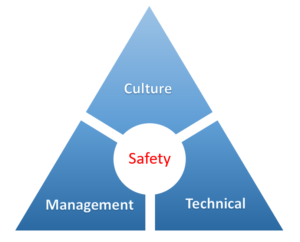
Each of these aspects highlight different key pieces needed in an organization to ensure it can operate safely. Expanding on each aspect of the safety triangle:
Technical – characterization and control of hazards
Management – policies and procedures for safety
Cultural – motivating people to do things safely
Statistics on incidents
OSHA – Occupational Safety & Health Administration
\begin{align*}
& \text{incident rate} = \text{incidents per 100 worker per year}\\
& \text{ every working year} = 2000 \text{ hours}\\
& \text{incident rate} = \text{incidents per 200,000 hours exposure}
\end{align*}
FAR – Fatal Accident Rate
\begin{align*}
& \text{fatalities per 1000 employee over their working life}\\
& =10^8\text{ hours of exposure} \\
& 50 \text{ years pf exposure} × 2000 \text{ hrs/yr} × 1000 \text{ employees}
\end{align*}
Fatality Rate – per person per year – exposure poorly defined
For these statistics, smaller is better!
Exercise: Incident Rate Calculation
Suppose 2 workers have experienced an incident of CO exposure on our site while the total hours of exposure for all workers for the risk of CO exposure are 720,000 hours. Calculate the OSHA incident rate for CO exposure on the site.
Solution
\begin{align*}
\text{incident rate} & = \text{number of incident exposure}×\frac{200,000}{\text{number of working hours}}\\
& =2×\frac{200,000}{720,000}\\
& = 0.56
\end{align*}
Exercise: Incident Rate Conversion
Suppose a fatal accident has an OSHA incident rate of [latex]8.9×10^{-5}[/latex], express the incident rate in the form of the FAR accident rate.
Solution
\begin{align*}
\text{fatal accident rate} & = \frac{\text{OSHA incident rate}×10^8 \text{hours}}{200,000 \text{hours}}\\
& = \frac{8.9×10^{-5}×10^8}{200,000}\\
& = 0.0445
\end{align*}
Personal vs. Process Safety
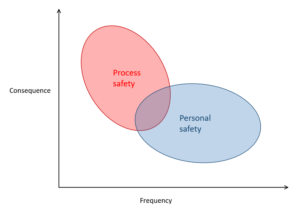
process safety – low frequency, potentially higher consequence
personal safety – higher frequency, generally lower consequence
Why do Accidents Occur?
We choose to handle dangerous process materials and energies to make value-added products that can be very beneficial.
- If we handle these materials, there is a potential for accidents
- Things can be done to reduce the likelihood and severity of accidents to negligible or tolerable levels
How do accidents occur?
Major Process Industry Incidents and Their Properties
Here we consider the impact of three general categories of the worst types of process industry incidents fire, explosion, and toxic release.
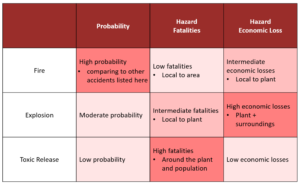
The Hazard Pyramid
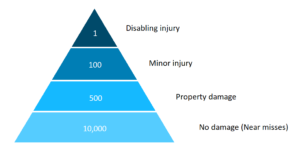
The incidents that do not result in any damage (or near misses) are defined by when the event did not lead to harm but only because of happenstance or luck[latex]^{[1]}[/latex]. It is important for us to report these incidents and learn from them.
Exercise: Reporting Incidents at UBC
UBC Centralized Accident / Incident Reporting System (CAIRS) is a platform for all UBC students, visitors, and employees to report incidents in UBC workspaces. Which of the following statement is true about CAIRS? Explain your answer.
a. Only incidents involving death or injury workers are required to be immediately reported on CAIRS
b. Only incidents involving death, injury, or property damage of workers are required to be immediately reported on CAIRS
c. All incidents and accidents that occur in UBC workspaces must be reported, including near misses that do not result in any damage
d. If you have reported the incident to your supervisor, you do not need to report the incident on CAIRS
Solution
Answer: c
All incidents should be reported regardless of if the incident has led to physical damage to workers or property damage. Reporting near misses is an important way for us to learn from them and mitigate the incidents to avoid causing harm to people or properties.
All accidents/incidents involving UBC workers (faculty, staff & student workers) or practicum students must be immediately reported to the responsible supervisor and then on-line through the UBC Centralized Accident/Incident Reporting System (CAIRS).
Common Types of Process Industry Incidents
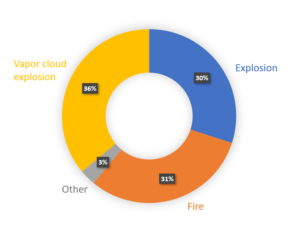
One Way to Tackle Hazards
Inherently safer design: permanently and inseparably reduce or eliminate process hazards [latex]\rightarrow[/latex] what we don’t have in the process we don’t need to control
Design Strategies to Enhance Safety
For every risk assessment, ask:
- What can go wrong & how?
- What are the chances (probability)?
- What are the consequences?
If the risk is not acceptable, modify the design and go through the risk assessment process again before proceeding to the next stage of the design process.
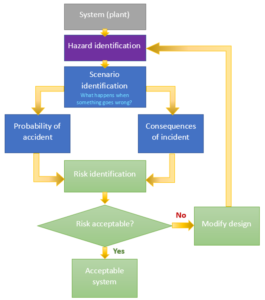
Inherently Safer Design Strategies
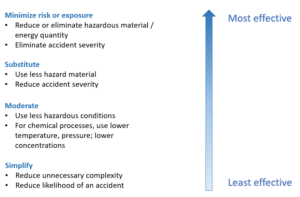
When should we incorporate safety in the design process?
We can implement changes in designs to improve safety at any point. But as with most design processes, it is generally least expensive to do so at the start of the design process.
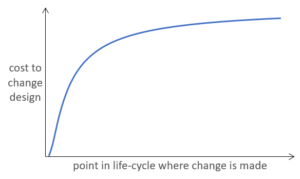
Links for Resources:
Textbook for Safety:
D. A. Crowl and J. F. Louvar Chemical Process Safety: Fundamentals with Applications Fourth Edition, 2019 or Third Edition, 2011 Available on Library Online Course Reserves on Canvas or through UBC Library: Chemical Process Safety: Fundamentals with Applications – UBC library
Roy E. Sanders Chemical Process Safety : Learning from Case Histories Available on UBC Library: http://tinyurl.com/v232qe8
J. Foster and B. Barnetson Health and Safety in Canadian Workplaces https://www.aupress.ca/books/120259-health-and-safety-in-canadian-workplaces/
AICHE Certificate Program:
Safety in Chemical Process Industries https://www.aiche.org/ccps/community/technological-communities/safety-and-chemical-engineering-education-sache
Chemical Safety Hazard Investigation Board:https://www.csb.gov/
AICHE Center for Chemical Process Safety: https://www.aiche.org/ccps
Significant Disasters
Flixborough, England, 1974
- rupture inadequately supported bypass pipe, 155 °C, 7.9 atm
- vapor cloud 30 ton cyclohexane
- explosion & fire inventories (10 days)
- 28 killed, 36 + 53 injured, much damage
Link to source:
https://www.hse.gov.uk/comah/sragtech/caseflixboroug74.htm
Seveso, Italy, 1976
- reactor out of control ( run away )
- vapor cloud 2 kg dioxin
- 700 affected, 730 evacuated
- 252 km contaminated ( 40 factories )
Link to source:
https://www.hse.gov.uk/comah/sragtech/caseseveso76.htm
Bhopal, India, 1984
- not operating scrubber & flare system
- vapor cloud 25 ton toxic MIC
- 2000 killed, 20.000 injured, no damage
Link to source:
https://www.hse.gov.uk/comah/sragtech/caseuncarbide84.htm
Oppau, Germany, 1921
- 4500 tonnes of ammonium sulfate and ammonium nitrate explosion
- over 500 killed, over 2000 injured
- forming a crator 125m long and 19m deep
Link to source:
https://h2g2.com/edited_entry/A11816697
Texas city, Texas, US, 1947
- fire on cargo containing 2200 tonnes of ammonia nitrate, mishandled with steam
- chain reaction of fire and explosion
- over 581 killed
- one of the largest non-nulear explosions in the history
Link to source:
References
[1] J. Foster and B. Barnetson, Health and Safety in Canadian Workplaces, Athabasca University, Edmonton, AB, Canada, 2016.
Some texts and figures are adopted from: D. A. Crowl and J. F. Louvar Chemical Process Safety: Fundamentals with Applications Fourth Edition, 2019


Feedback/Errata